Winners 2016 CCIM Forecast Competition:
- Multi-Family: Ryan Terrell, Managing Director, Greystar
- Land: Keith Edwards, CCIM, SIOR, Senior Vice President, Caldwell Companies
- Industrial: Trent Agnew, Director, HFF
- Office: Bob Parsley, SIOR, Co-chairman & Principal, Colliers International
- Retail: Micha van Marcke, CCIM, Senior Vice President, Transwestern
Overview of the 2017 Competition:
Houston’s commercial real estate market will continue a strong level of activity during 2017 amid a slowdown the last two years, with the office market still struggling in its comeback.
That is the consensus of participants during the 2017 CCIM Forecast Competition on Feb. 17. The 24th annual competition offers two perspectives on market trends by local real estate broker experts in the office, retail, industrial, land and multi-family markets. Sponsored by the CCIM Houston/Gulf Coast Chapter, a moderator for each land use keeps the conversation flowing by asking specific questions of each participant at the event in the CityCentre’s Norris Conference Center.
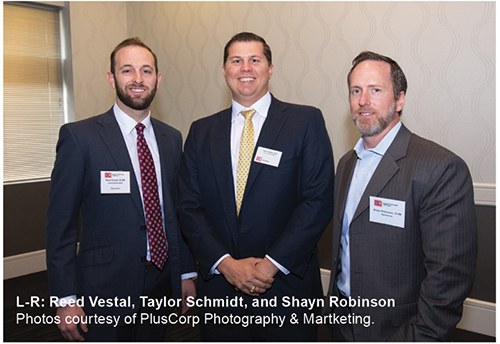
Dr. Mark Dotzour, a real estate economist and former chief economist of the Texas Real Estate Center at Texas A&M University who speaks to groups nationwide, offered a positive outlook in the keynote address, saying he sees national enthusiasm everywhere since the presidential election.
The promise of new jobs and less regulation has both individuals and corporations optimistic for 2017, even in Houston, he said. “I have seen amazing optimism, the whole country feels good,” he said. “Household income net worth is higher than ever; Americans have never been richer than before. And the small business outlook is strong.”
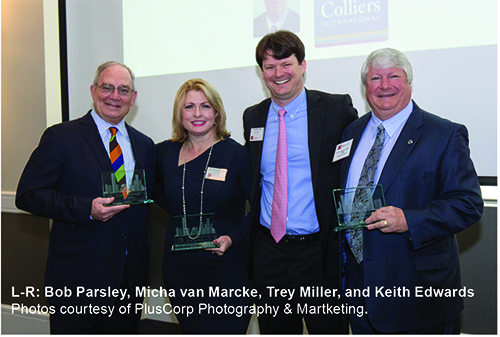
Only two things could derail that optimism, according to Dotzour: The suggested border tax and getting rid of too many tax loopholes. Some are questioning how tax rates can be cut and revenue increased. He said new tax policies will be bullish for job creation, wage increases and the single-family market but some key industries like construction could see immigration policies constricting the labor supply. He said federal interest rates will be rising along with mortgage rates, but he predicts by “not much.”
Office
Moderator: Chip Colvill, Colvill Office Properties
Contestants: Steve Burkett, CCIM, Executive Vice President, JLL and Rich Pancioli, CCIM, Senior Vice President, CBRE
Both tenant rep brokers predicted negative office space absorption this year, ranging between Pancioli’s negative 1.5 million square feet to Burkett’s negative 2.0 million square feet. They agreed that the large sublease market is the big factor and do not “anticipate big change” soon, but they said sublease space can be a great advantage as the big blocks become more competitive as time passes. Both also reported a large upswing in leases signed in sublease spaces in 2016.
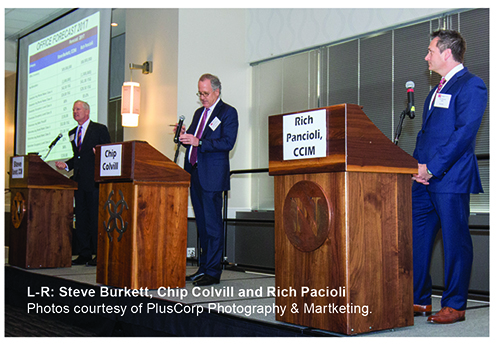
The two brokers, who represent tenants in the market, noted that other industries like medical and IT are “upping their presence” to make up for the lost energy jobs, and noted that “Houston has more tech jobs than Austin.” They did mention concern about additional “shadow space with short terms rolling over soon,” bringing more space to the market. And unlike the 1980s’ overbuilt office market, they are informing clients that tenants, not developers, are responsible for the current amount of available space. Many newer buildings with space available were build-to-suit for specific companies who now have cut back on office space needs.
Other trends the brokers noted include the increase of available co-working space, saying the market is trying to get it going but not quite show how to do it, determining how it fits in with other leasing opportunities. They also predicted more bankruptcies this year
Industrial
Moderator: Reed Vestal, CCIM, Senior Director, Lee & Associates
Contestants: Tom Lynch, SIOR, Senior Vice President, CBRE and Rob Stillwell, CCIM, Senior Managing Director, Newmark Grubb Knight Frank
Houston’s industrial market is stable, with occupancies as high as 95% for dock-high space, both contestants agree. They also predicted not much change in 2017, with absorption ranging from 4.7 million square feet to 6 million square feet for the year.
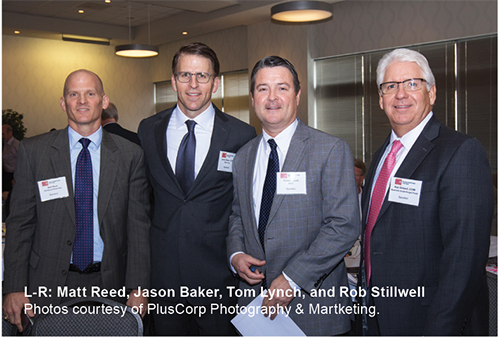
They acknowledged that Houston is now so spread out with a growing population that a lot of new buildings were built in places unheard of a few years ago. Developers have been careful and not overbuilt, which is why the population increases are creating a need for more distribution and warehouse space for retailers such as IKEA and e-commerce companies like Amazon. They reported that a tenant such as Amazon with higher clearance and other specialty construction can change the development costs, jumping from an average $50 per square foot to $180 per square foot. One trend that is clearly a value-add is if a building has 40’ to 50’ clearances.
They both agreed land prices have driven up so high that most industrial development does not make economic sense. Even obsolete buildings have issues with land pricing; it is very hard to find land at $5 to $6 per square foot that has access, water availability, etc. Maintaining that Houston developers have contained themselves during the last cycle, they reported no new industrial groundbreakings the last two quarters.
The two largest markets continuing to show the most activity are the Northwest and Southeast sectors.
Land
Moderator: Jane Paige, CCIM, Chief Executive Officer & Partner, Lionstone Investments
Contestants: David Adams, Managing Director, HFF and Kirk Laguarta, Designated Broker, Land Advisors Organization
Saying there is no rush for land, both brokers said the “market is a lot better than we thought.” The Houston market is very stable, according to Laguarta, who said 2016 marked the 20th consecutive year of 18,000 or more annual home starts, a record held by the city nationwide. Adams said “investors are moving forward quickly,” with many “circling Houston.”
The two land experts’ predictions of 26,950 (Laguarta) and 27,500 (Adams) single-family, residential starts confirm their optimism. Builders should have options based on their forecasts for the number of developed new lots, which range from 28,500 to 32,000 new lots, with Laguarta on the higher side. But when it comes to master-planned, 65-foot lots, the two land brokers varied on average pricing, with Laguarta on the low end at $76,375 while Adams forecast $83,500 per lot.
Land pricing predicted has Adams on the higher end for Midtown land, $110 vs. $90 average per square foot, and for suburban land sites between 100 and 250 acres, predicting a $47,500 average per acre price vs. Laguarta’s $42,500 per acre price. But Laguarta believes retailers will pay more for tracts smaller than 5 acres outside the Beltway: $12 per square foot vs. Adams’ $10 per square foot.
Adams said the volume of sales in 2016 had decreased but not so much the pricing. He reported that there are a lot of real estate loans that will need refinancing this year, and hopefully the interest rate hikes will be small. They both discussed how new immigration laws could affect the labor supply and how e-commerce can affect land use. Parking in Houston takes up 1/3 of the land allocation, and e-commerce has just taken the shift away from regional malls, they said.
Laguarta, who specializes in multi-acre land sales for residential communities, said it takes at least six to 12 months to complete a land sale, and then another 12 to 36 months to develop the land. He said lot development activity has slowed the last few years, so he believes this area of sales should be picking up this year through 2019.
When asked what keeps them up at night, Laguarta said trying to keep up with world events, especially how those events affect our economy, and being ready for the world’s next big technological change.
Retail
Moderator: Debbie Adams, CCIM, Principal, Edge Realty Partners
Contestants: Jason Baker, CCIM, Principal, Baker Katz and Matt Reed, Vice President, NewQuest Properties
Saying the retail market is “fantastic and remains strong,” both retail brokers could not suppress their optimism for this commercial market sector. With almost identical occupancy and absorption forecasts, both Baker and Reed said the steady population growth the last few years with little retail development has prompted the need for additional retail.
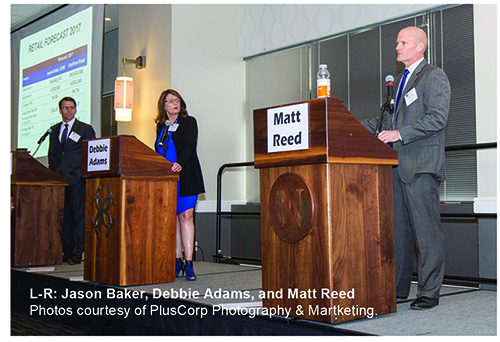
The occupancy forecast for 2017 ranges between 94.7% and 94.9% with absorption from 4.5 million to 4.65 million square feet. Noting the price of land as becoming a real factor in development, Baker said land that previously sold for “$5 per square foot is now $10 to $12, and we have to try and make the proforma work.”
The two brokers also were very close when forecasting rental rates between $16.25 and $16.67 for anchored space larger than 20,000 square feet and average sales price at $156.00 to $156.25 per square foot for retail greater than 25,000 square feet.
Both said most retailers are becoming more efficient, citing Ross stores as changing their store size from an average 80,000 square feet to 22,000 square feet. Another new trend they mentioned is the larger distribution spaces required to house products if a retailer reduces their footprint. They also mentioned the many grocery concepts still going strong, but the larger market shares are still divided between Kroger, HEB and Walmart. Baker shared a quote to explain the grocery business: “Feed the masses, you get rich. Feed the wealthy, you go broke,” explaining why some stores, like those catering to higher-end consumers, can develop issues.
Another trend mentioned is the use of alcohol, i.e., how alcohol is being added to so many different retail venues from getting a haircut to playing golf to going to the movies. They also said social media is playing a more important role in a retailer’s success, with the retailer having to incorporate its physical store with its online presence to create a consistent marketing concept. Both also said that experience is very important when it comes to retail, which could be a factor in the success new retailers entering the Houston market.
Multi-Family
Moderator: Greg W. Young, Senior Vice President & Office Co-Manager, Grandbridge Real Estate Capital
Contestants: Ryan Epstein, Senior Managing Director, Berkadia and Matthew R. Rotan, Vice Chairman, ARA, A Newmark Company
Predicting a new recovery in Houston’s economic picture in 2017, the multi-family market will begin to stabilize during the first half of the year, according to Epstein. Both forecast positive net absorption for the year: Rotan predicted 8,800 units while Epstein was more positive with 12,000 units. Both predicted rental rates from $1.46 to $1.50 per square foot for Class A and $1.07 to $1.08 per square foot for Class B, with Epstein on the lower range. Occupancy rates were forecast in the 80% to 83% for Class A and 90% to 92% for Class B.
Saying capital is available, the major difference in the two brokers’ outlooks came down to average sales per square foot. Epstein forecast an average sales price of $78,000, or $97.00 per square foot, while Rotan forecast much lower pricing, $62,000 or $71.00 per square foot.
Epstein was bullish on the market, noting that only 15,713 units were under construction at year-end 2016, compared to 24,709 units delivered in 2016, and two-thirds of those will begin leasing by the end of the first quarter. “This will create an opportunity for the multi-family market to catch its breath and allow units already leasing to be absorbed through the balance of 2017,” Epstein reported.


